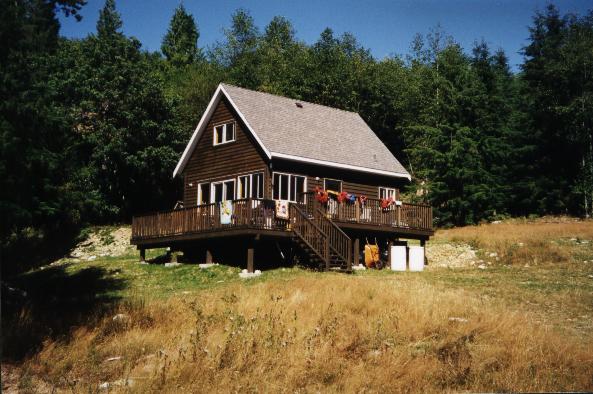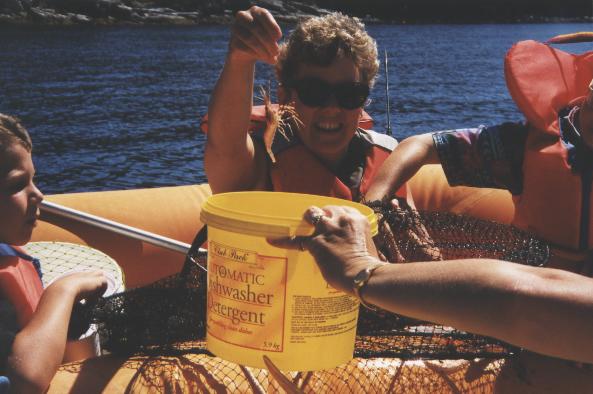 |
|||||||||||||||||||||||||||||
|
|
My Writing |
||||||||||||||||||||||||||||
In Part 1 of this series we looked at the Hardy Island property of my friends Paul and Cheryl Miniato, describing it and the pleasurable visits we've had there. Part 2 went over a short history of the island. In today's installment we look at the four year effort to sub-divide the property for development and the costs incurred in building a cabin, getting a boat and sundry other expenses of island life.
The Miniato Cabin It's Easier in China!Developing real estate is a challenge at the best of times. Developing real estate on a relatively remote island with no electricity, no ferry services, no roads, no dock - nothing - well, that's a challenge and a half. The odyssey from purchase to subdivision for the Hardy Island consortium took over three years. Then it took another year for the title deeds to be registered and to build the cabin. In the Spring of 1994 my friends Paul and Cheryl Miniato bought a piece of Hardy Island as part of a group of sixteen families. They bought a holding company that had title to a 723 acre lot, the largest of only four island lots. Each family chipped in $50,000 for their share. That paid the $750,000 price for the land company and left $50,000 in the kitty for future expenses. One of the women in the group served as President of the corporation, an unpaid position. Another member of the group served as Treasurer and accountant. All the members have email and much of the business of the company was discussed electronically. There was a lot of business to discuss. In the Fall of '94, the group started what Paul calls "a series of endless surveys, meetings and reports". They hired a development consultant but her report was terrible. It would involve tripling the amount of money they had to invest. So they fired her and fretted. Group dynamics was also a challenge - not all of group saw eye to eye all the time. The participants ranged from experienced cottagers to complete neophytes. It was full year later before they decided to hire someone from within their own ranks who had land development experience as Project Manager. And they hired a new consultant. After extensive interviews with the 16 families, preliminary lot lines were drawn up and a formal sub-division application was filed in December of 1995. The Project Manager was responsible for shepherding the proposal through the various government agencies - eight or so. This took the better part of 1996. What agencies? Well... The overall authority for the development, oddly enough, was the provincial Ministry of Highways. They also had to deal with the Ministries of Health, Municipal Affairs, and Environment. Then there was the municipal authority, the Sechelt Regional District and the federal Department of Fisheries & Oceans. Whew! You might recall that old song from the Sixties, Alice's Restaurant by Arlo Guthrie. He sang about how he got "injected, inspected, detected, infected, neglected and selected". That's how the Hardy Island group must have felt with all the bureaucratic rigamarole they had to go through. They had to build roads, locate septic fields, drill wells, conduct an archeological study, an eagle roost study, and a geo-technical study among other things in order to proceed. In fact, the Project Manager logged over 700 phone calls to various government agencies during the sub-division process. Some of these studies resulted in usage restrictions. In fact, after the property was successfully subdivided, the Project Manager had occasion to develop a project in Beijing, China - the heart of modern communism. The Chinese authorities, he says, were easier to deal with. The cost of all these studies and requisite road building, well digging, septic location and so on came to $550,000. This included a fee for, of all things, a well witcher, who successfully located all the wellsites. They generated $500,000 towards the cost by having the land selectively logged, leaving a deficit of $50,000, which they financed. Although not a government requirement, the group built a communal dock in the Spring of 1996. Some of the company's Annual General Meetings were actually held on the dock! The corporation decided to sub-divide the property into 21 lots. Title to sixteen of them would go to the share-owners. The rest would be retained by the company to sell later to generate revenues for further development. In fact, they were unable to locate a septic field on one of the lots and only 20 were registered. To divide up the lots among the shareowners in an equitable manner, they had an appraiser evaluate each lot as a percentage of the whole. The lots deemed more valuable were assigned a higher percentage of the total value of the property. Then the partners each submitted three choices for their lot. Conflicts were resolved and each got a lot to their liking without too much difficulty. The ones who got more expensive lots had to pay an extra amount into the kitty. The sums collected were divided equally among all the shareholders, so those with lesser valued lots ended up with a rebate on their original purchase price. My friends the Miniatos ended up with the most highly valued lot. But the government, at the last minute, decided they want an easement for a future highway right of way along the edge of their property and they ended up paying only $5000 extra. It was a lengthy road from initial purchase in April 1994 to final divvying up of the lots in February 1998. But finally each family had registered freehold title to their lots. "Sub-division," says Paul, "is not for the faint of heart!" The Lot DevelopedWith title to their lot finally secured, the Miniatos set about developing their land. Of the sixteen owners, only two have built on their land. Another two are in the process of development. But development is also not an easy nor inexpensive process. Just getting there isn't cheap. It costs over $50 each way for a family of four by ferry to get to Saltery Bay from Vancouver, not to mention gas and sundry travel expenses. And then the Miniatos were landlubbers when they first bought the property. They went from bumming a ride with the old salt (see Part 1) to buying an 18 foot runabout to buying an all weather boat. Their current boat, a second hand number, was obtained cheaply enough at a modest $3000. But they had to spend over $2000 for repairs and an engine overhaul. With other expenses, they shelled out over $7000. Then there are recurring costs. Besides fuel, there is moorage at $200 every three months, insurance and other expenses. About $1000 a summer. The cabin itself came as a reasonably priced kit at $25,500. But it had to be barged out. They hired contractors to erect it. They had to have a foundation built. There was site prep work before that. The cost breakdown in the following table gives you the idea.
On top of that, there is another recurring cost - taxes. Even though the island has no services - no municipally maintained roads, no sewers, no municipal water, no policing, no fire protection, not a damn thing, they are assessed $1000 a year in taxes on an evaluation of $150,000. They pay the same tax rate that they would pay if they had a home of the same value in the town of Sechelt itself. And politicians wonder why the people have such disdain for government! There are revenue possibilities in the future. They have 62 acres, including loggable areas, but logging is messy, noisy and a pain in the butt, so they are not interested in doing that. The area is zoned for ten acre lots, so they could in theory spin off five lots to sell. But... well you just read how difficult sub-dividing is. Just finding good locations for septic fields would prove formidable. They don't expect to subdivide. Another owner has the lot on which the former granite quarry is located. It has large blocks of granite already cut but never moved. The owner is thinking of re-establishing the granite business. The neighbours are not too crazy about this idea.
Hmm! Delicious! A fresh prawn from the trap! Basically, this is the Miniato's summer retreat and they're content to keep it that way. The value of the lot, if they ever sell it, is probably around $200,00 to $250,000. But it is a thinly traded market and may take time to sell. It will increase in value as the island becomes more developed. That's not a bad return on their investment, although the best return is the pleasure they get from using the island and the pride of knowing they have created something where before there was nothing. Postscript: The Miniatos have since sold the property at a nice profit. |
|
||||||||||||||||||||||||||||
|
|
|||||||||||||||||||||||||||||
|
Contents copyright ©
Marco den Ouden All Rights reserved |
|||||||||||||||||||||||||||||
|
|
|||||||||||||||||||||||||||||















